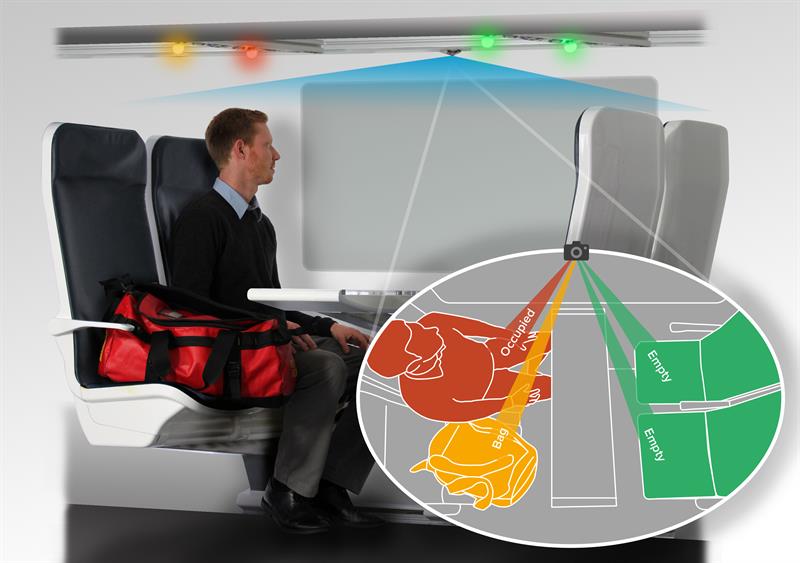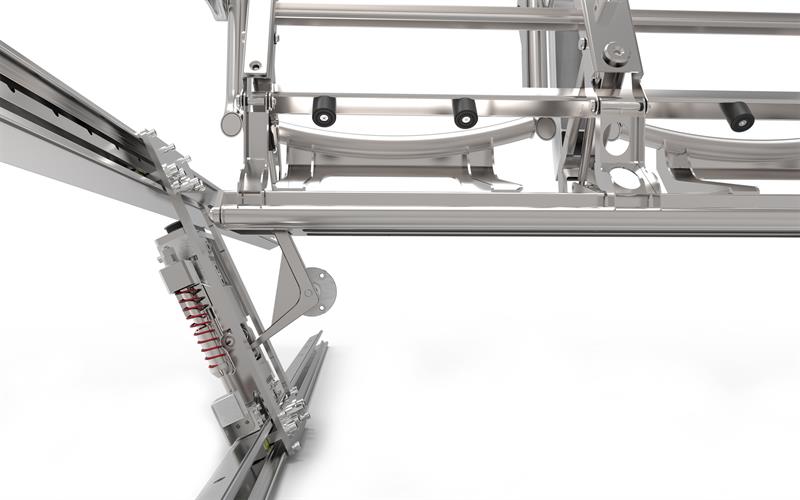The overhead image-based occupancy sensor has been designed by Cambridgeshire-based product design consultancy 42 Technology as part of its Adaptable Carriage project. The sensor is also compatible with existing train carriages and coaches and might be used, for example, to help passengers more easily identify carriages with empty seats.
The Adaptable Carriage flexible seating system has been designed as an innovative but practical way for train operators to configure specific carriages on demand to carry either passengers or ‘low density, high value’ packages, such as deliveries from online retailers and other time-sensitive cargo that would otherwise go by road.
All the seats, tables and draught screens within each section of an Adaptable Carriage are connected together and mounted on a rail system so they can be moved along the length of the carriage and stowed or locked into position to carry passengers. The reconfiguration process is fully automated, takes under three minutes to complete and as a result, the 20 rows of seats in a typical passenger carriage can be compressed to create a cargo space equivalent to an articulated lorry.
As part of their development programme, the design team at 42 Technology needed to find a low cost and failsafe way to detect if any passengers or objects were still in a carriage so it can be investigated before being reconfigured. The team reviewed several existing passenger counting and presence detection technologies before deciding they needed a more reliable and cost-effective approach.
 The sensor uses a single camera to cover an area of up to four seats and a table. The system retains intermittent still images and takes another image at intervals so it can automatically compensate for changes in light intensity, for example, when the train goes into a tunnel and natural light from a window is replaced with the train’s on-board lighting. It then compares its most recently captured image against a corrected background.
The sensor uses a single camera to cover an area of up to four seats and a table. The system retains intermittent still images and takes another image at intervals so it can automatically compensate for changes in light intensity, for example, when the train goes into a tunnel and natural light from a window is replaced with the train’s on-board lighting. It then compares its most recently captured image against a corrected background.
No video data is recorded or retained, which avoids any potential privacy issues. The output is a binary image and the sensor behaves like an adaptive filter to detect the presence of an object or a person within a number of pre-defined regions of interest.
42 Technology has built a proof-of-principle demonstrator for its sensor using an ARM-based CPU and camera module allowing it to be demonstrated for a range of different applications and use cases. The consultancy is looking to work with potential partners to develop these cost-effective safety solutions for other areas of industry and through to manufacture.
 The Adaptable Carriage system has been designed so that all its seat sliding and locking mechanisms are ‘packaged’ between the two sets of rails that are currently used in contemporary carriage designs to attach cantilevered seats to the walls of the carriage. Each pair of seats are attached to a bogie mechanism that can slide along the carriage in a set of wall mounted running rails, rather than rails in the floor.
The Adaptable Carriage system has been designed so that all its seat sliding and locking mechanisms are ‘packaged’ between the two sets of rails that are currently used in contemporary carriage designs to attach cantilevered seats to the walls of the carriage. Each pair of seats are attached to a bogie mechanism that can slide along the carriage in a set of wall mounted running rails, rather than rails in the floor.
The overall mechanical design for the seating system was modelled in CAD with the team building several proof of principle prototypes to test potential designs in hardware, as well as on screen. A single seat test rig was used to help establish real loads and forces with a Lutron FG-5000A force gauge used to measure the forces required to move the seats along the rails. The data was then input back into SolidWorks for the required FEA simulations. A Mecmesin MultiTest 2.5-i force testing system was used to measure the elasticity of the bogies’ tyres and to help select the right material for them.
Adaptable Carriage uses a simple machine control switch architecture with off-the-shelf sensors and switches to confirm that everything is correctly positioned and safely locked into place.
Each pair of seats has two steel safety locking pins that go through the seat running rails into the bogies, effectively acting as ‘belt and braces’ for the system. Magnetic reed switches are used to confirm the correct positioning of the bogies before the locking pins can engage, and safety-rated contact switches at the top and bottom of each locking pin confirm that they are either down or up and out of the way so the bogies can move.
One of the key design innovations for Adaptable Carriage is the use of a forward-folding seat design that allows any rubbish left on seats to be tipped onto the floor for easier cleaning after the seats have been stowed. The system uses a scissor-jack type mechanism to put a load onto a lever that pulls the seats into their seated positions, and at the same time compresses the silicone-rubber tyres on the bogie wheels against their running rail. Low cost micro-switches on the lever arms tell the control system when to stop moving each mechanism up or down.
Industry support
42 Technology is working with a number of organisations from across the rail industry stakeholder group who are interested in getting involved in the first commercial trials for Adaptable Carriage. However, the complete seating system – or elements of it – could also be of interest for other applications such as creating a small amount of space on demand within trains or buses to accommodate wheelchair users, bicycles or for extra luggage on airport routes.
The occupancy sensor also offers the potential for low cost presence detection for a range of other applications too, not just to highlight when passengers accidentally leave their belongings behind or to report seat status. The company has highlighted another potential use case for the underground to alert passengers who are standing too close to a platform edge or as a kill switch for industrial machinery and robot enclosures. One thing is for sure, as transport operators on air, sea and land seek more flexibility between freight and passengers, adaptable carriages are going to find increasing application.





